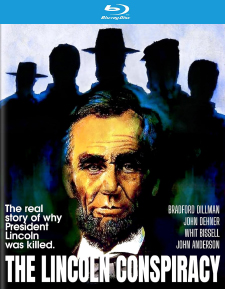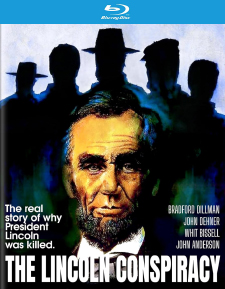Lincoln Conspiracy, The (Blu-ray Review)

Director
James L. ConwayRelease Date(s)
1977 (March 12, 2024)Studio(s)
Sunn Classic Pictures (Kino Lorber Studio Classics)- Film/Program Grade: B-
- Video Grade: A
- Audio Grade: A-
- Extras Grade: B
Review
Two major facts about the assassination of Abraham Lincoln are common knowledge. The President was attending a performance at Ford’s Theater when he was shot, and John Wilkes Booth was the assassin. The Lincoln Conspiracy raises questions about the shooting and its aftermath that suggest there’s more to the story than we learned in history class.
The filmmakers maintain that the film is based on extensive and costly research. A list of their sources they provide at the end of the film includes documents, archival material, and books on the subject. Among the questions they pose: Why wasn’t Lincoln properly protected at the theater that night? A man purported to be Booth was killed in the barn at Garret’s farm. Why was the body buried so quickly and why was no picture taken of the body? How was Booth able to escape and never be captured?
Presented as a “re-enactment,” the film focuses on opposition by some Republicans in government to Lincoln’s plan for post-Civil War unification of the country for fear that his reconstruction policy would shift power in Congress to the Democrats. Among these men were Secretary of War Edwin Stanton (Robert Middleton, Friendly Persuasion); Col. Lafayette C. Baker (John Dehner, The Left Handed Gun), head of what today would be the Secret Service; and Senator John Conness (Whit Bissell, Birdman of Alcatraz). To prevent this possibility, they plotted to kidnap Lincoln (John Anderson, Psycho) and remove him from his duties as President.
John Wilkes Booth (Bradford Dillman, The Enforcer) also planned to kidnap the President but was not very good at getting the details right and enlisting reliable men to assist him. His previous attempt to kidnap the President was bungled. Stanton and his collaborators knew of Booth but warned him off any further attempts, fearing his ineptness would eventually implicate them. After the assassination, Booth left behind a diary containing incriminating evidence against Stanton’s group. It became vital to them that Booth never live to testify.
The key argument presented by the film is that Booth was not the person shot and killed by soldiers in the barn. When word spread that Booth had been killed, Stanton and his fellow plotters had no choice but to frame the men who had already been captured as Booth’s co-conspirators. They were given speedy trials without proper representation and four of them were hanged.
The Lincoln Conspiracy depends on a methodical narrative, delivered at key points by James Greene and Brad Crandall, so that we understand the personalities and politics involved at the time. Lincoln was not popular with key government officials, Southerners, and political enemies. His assassination is portrayed as an event whose details were kept from the public to protect the highly placed conspirators. The narration states that Booth’s getaway was traced as far as New York, where his trail vanished.
In making its case, the film is reminiscent of the controversy surrounding the Kennedy assassination. In both cases, the official versions raise unresolved questions. Though considerably more reliable forensic methods were available after the Kennedy assassination, disputed “facts” continue to arise and eyewitness testimony is at odds with the Warren Report’s findings. Despite the numerous academic sources listed in The Lincoln Conspiracy to give it credibility, there’s no definitive proof that Booth got away or that Stanton et al. conspired in a secret plot.
Performances from the whole cast are solid and effective. Jonathan Cobbler’s script gives each man a number of good scenes, and production values are excellent, with battle scenes, costumes, and set decoration suggestive of a big-budget production. The one exception is a series of unconvincing beards and mustaches.
Many of the characters wear false beards that look more like Dollar Store bargain bin retrievals than professional make-up. The most outlandish is Stanton’s long, flowing, bi-colored beard so distracting that it could be a character in itself. Booth’s solid black mustache looks like a Halloween stick-on. And Lincoln’s beard resembles a dead squirrel glued across his cheeks and chin. Photographs exist of these men. Did the make-up department even check them out? Or did budgetary constraints necessitate these laughable facial appliances?
The Lincoln Conspiracy was shot by director of photography Henning Schellerup on 35 mm film with spherical lenses, and presented in the aspect ratio of 1.85:1. The Blu-ray release from Kino Lorber is sourced from a 2017 HD Master prepared by Paramount Pictures. Clarity and contrast are excellent. There are no distracting visual imperfections. Color is rich and vibrant. Complexions are rendered naturally and details, such as clothing, soldiers’ gear, wooden slats on a barn, a prison yard, and a gallows are well delineated.
The soundtrack is English DTS-HD Master Audio. English SDH subtitles are an available option. Dialogue is clear and distinct. Sound effects include horses galloping, men marching, gunfire, a gallows trap door opening, a carriage clattering on a dirt road, and fire crackling through a barn.
Bonus materials on the Region A Blu-ray release from Kino Lorber include the following:
- Audio Commentary by Howard S. Berger and James L. Conway
- 3 Days of the Condor Trailer (3:05)
- Winter Kills Trailer (3:20)
- The Eiger Sanction Trailer (2:50)
- Marathon Man Trailer (2:39)
- The Organization Trailer (2:54)
- Rosebud Trailer (2:41)
- The Groundstar Conspiracy Trailer (2:37)
- The Internecine Project Trailer (3:00)
Audio Commentary – In this commentary, moderated by film historian Howard S. Berger, director James L. Conway notes that The Lincoln Conspiracy, shot in the autumn of 1977, came out around the same time as Star Wars. The cast is composed of character actors who were regularly employed in movies and on television. They appeared in A films, low-budget pictures and television because “A job is a job.” The director of photography was known for exploitation cinema. Conway was involved with Sun Classics for quite a while. He was given a chance to direct an industrial film there and directed from that point on. Sun Classics was known for “four walling”—renting theaters for limited showings and keeping all of the box office proceeds. In Search of Noah’s Ark, directed by Conway, was made for $600,000 and grossed $55 million. Amazed at Sun’s profits, theaters returned to a traditional distribution deal with The Lincoln Conspiracy. Because payment was delayed, financial pressure was placed on Sun Classics. Sun believed in testing both completed films and concepts. Audience test results were better for completed films, but the testing was never as accurate in predicting audience interest. After his stint with Sun, Conway had long associations with Aaron Spelling Productions and later Paramount, where he directed episodes of several Star Trek franchise series. His visual style includes subtle ways of moving the camera, interesting tracking shots, and crane shots. Conway’s “use of close-ups is really great.” He will take the necessary time to create interesting screen movement. The Lincoln Conspiracy was shot in Savannah and Atlanta, Georgia. Casting was done in Los Angeles, Savannah, and Atlanta. A casting director suggested actors for the various roles and they were either hired outright or auditioned. The film’s editing took only a month. The time elapsed from the start of filming to release in theaters was six months. The distributors knew the release date even before shooting began.
Though The Lincoln Conspiracy makes an intriguing case, in its attempt to answer questions it raises even more. We never get any definitive proof to substantiate the film’s theories. Director James L. Conway has created a speculative history rather than an irrefutable fact-based revelation. If you approach the film as an interesting entertainment with historical figures as protagonists, you may enjoy it despite its being a bit too simplistic in its putting together one “What if...” after another.
- Dennis Seuling

